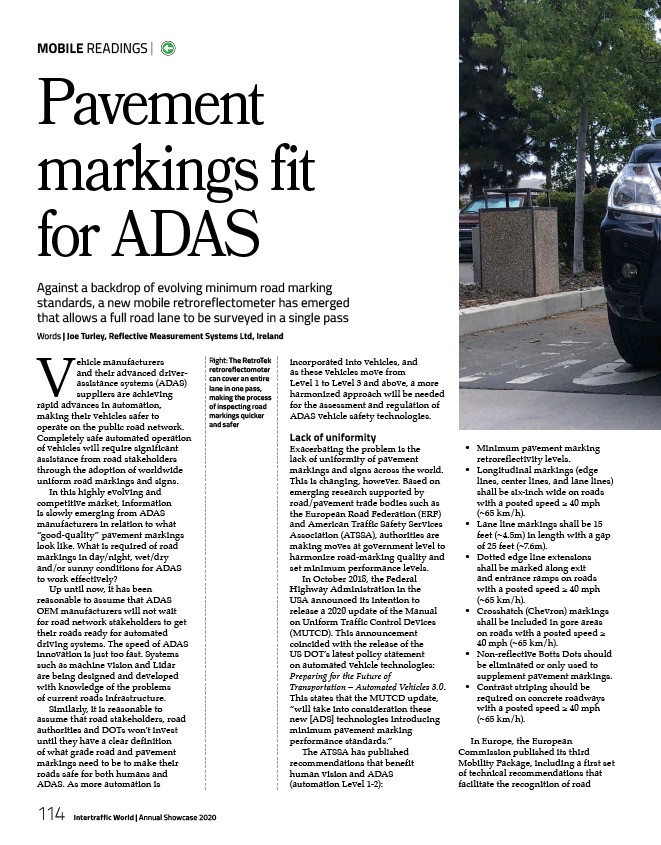
MOBILE READINGS |
Against a backdrop of evolving minimum road marking
standards, a new mobile retroreflectometer has emerged
that allows a full road lane to be surveyed in a single pass
Words | Joe Turley, Reflective Measurement Systems Ltd, Ireland
Right: The RetroTek
retroreflectomoter
can cover an entire
lane in one pass,
making the process
of inspecting road
markings quicker
and safer
Vehicle manufacturers
and their advanced driverassistance
systems (ADAS)
suppliers are achieving
rapid advances in automation,
making their vehicles safer to
operate on the public road network.
Completely safe automated operation
of vehicles will require significant
assistance from road stakeholders
through the adoption of worldwide
uniform road markings and signs.
In this highly evolving and
competitive market, information
is slowly emerging from ADAS
manufacturers in relation to what
“good-quality” pavement markings
look like. What is required of road
markings in day/night, wet/dry
and/or sunny conditions for ADAS
to work effectively?
Up until now, it has been
reasonable to assume that ADAS
OEM manufacturers will not wait
for road network stakeholders to get
their roads ready for automated
driving systems. The speed of ADAS
innovation is just too fast. Systems
such as machine vision and Lidar
are being designed and developed
with knowledge of the problems
of current roads infrastructure.
Similarly, it is reasonable to
assume that road stakeholders, road
authorities and DOTs won’t invest
until they have a clear definition
of what grade road and pavement
markings need to be to make their
roads safe for both humans and
ADAS. As more automation is
Intertraffic World 114 | Annual Showcase 2020
incorporated into vehicles, and
as these vehicles move from
Level 1 to Level 3 and above, a more
harmonized approach will be needed
for the assessment and regulation of
ADAS vehicle safety technologies.
Lack of uniformity
Exacerbating the problem is the
lack of uniformity of pavement
markings and signs across the world.
This is changing, however. Based on
emerging research supported by
road/pavement trade bodies such as
the European Road Federation (ERF)
and American Traffic Safety Services
Association (ATSSA), authorities are
making moves at government level to
harmonize road-marking quality and
set minimum performance levels.
In October 2018, the Federal
Highway Administration in the
USA announced its intention to
release a 2020 update of the Manual
on Uniform Traffic Control Devices
(MUTCD). This announcement
coincided with the release of the
US DOT’s latest policy statement
on automated vehicle technologies:
Preparing for the Future of
Transportation – Automated Vehicles 3.0.
This states that the MUTCD update,
“will take into consideration these
new ADS technologies introducing
minimum pavement marking
performance standards.”
The ATSSA has published
recommendations that benefit
human vision and ADAS
(automation Level 1-2):
• Minimum pavement marking
retroreflectivity levels.
• Longitudinal markings (edge
lines, center lines, and lane lines)
shall be six-inch wide on roads
with a posted speed ≥ 40 mph
(~65 km/h).
• Lane line markings shall be 15
feet (~4.5m) in length with a gap
of 25 feet (~7.6m).
• Dotted edge line extensions
shall be marked along exit
and entrance ramps on roads
with a posted speed ≥ 40 mph
(~65 km/h).
• Crosshatch (Chevron) markings
shall be included in gore areas
on roads with a posted speed ≥
40 mph (~65 km/h).
• Non-reflective Botts Dots should
be eliminated or only used to
supplement pavement markings.
• Contrast striping should be
required on concrete roadways
with a posted speed ≥ 40 mph
(~65 km/h).
In Europe, the European
Commission published its third
Mobility Package, including a first set
of technical recommendations that
facilitate the recognition of road
Pavement
markings fit
for ADAS